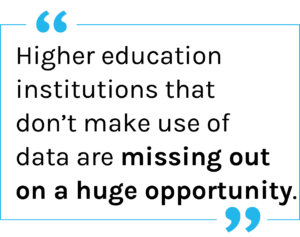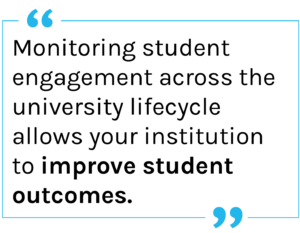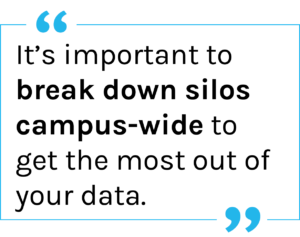Leverage data analytics and insights to make strategic decisions for your institution.
 Data is ubiquitous in the world today. According to EDUCAUSE, by one estimate, every person in the world created 1.7MB of data every second in 2020. Higher education institutions that don’t strive to make use of that data are missing out on a huge opportunity to identify problems and enact positive change. In fact, as noted in a joint statement by the Association for Institutional Research (AIR), EDUCAUSE, and the National Association of College and University Business Officers (NACUBO), “For every year we fail to use data effectively to improve operations or to make better financial and business decisions, we threaten the financial sustainability of our institutions.”
Data is ubiquitous in the world today. According to EDUCAUSE, by one estimate, every person in the world created 1.7MB of data every second in 2020. Higher education institutions that don’t strive to make use of that data are missing out on a huge opportunity to identify problems and enact positive change. In fact, as noted in a joint statement by the Association for Institutional Research (AIR), EDUCAUSE, and the National Association of College and University Business Officers (NACUBO), “For every year we fail to use data effectively to improve operations or to make better financial and business decisions, we threaten the financial sustainability of our institutions.”
If your institution begins to capture and analyze data in a strategic way, you can gain critical insights about diversity, student outcomes, faculty activity, and admissions and enrollment. Read on to learn more about the importance of data insights—and how to enable these insights campus-wide.
Why Should My Institution Care About Data?
Analyzing data across your institution can help you understand where your institution stands on many of the challenges facing higher education today. There are data analysis opportunities in every division and department of your school. Take admissions as an example. If your institution is facing declining enrollment like many colleges and universities, you could use data you’ve collected to learn what majors and programs the students who do enroll are choosing, and consider marketing or building on those programs. Your data might also help you discover if enrollments are declining at different rates for certain demographic groups, so you can target recruitment efforts where they are needed the most.
Once students are enrolled at your university, they have high expectations for a personalized and unique learning experience, driven by their experiences as technology natives. Monitoring student engagement and activity across their entire university lifecycle allows your institution to offer the right kind of support and guidance to give each of your students the best learning experience and improve student outcomes. The joint statement mentioned earlier put it nicely: “Helping students successfully achieve their academic goals is fundamental to mission, but it also can positively affect the bottom line… Advancing analytics can be expensive, but the return on investment can also be sizable and extends to long-term reputational returns far beyond adding revenue that would otherwise have been lost when students leave early.” The financial benefits of a robust data analytics solution are undeniable.
experiences as technology natives. Monitoring student engagement and activity across their entire university lifecycle allows your institution to offer the right kind of support and guidance to give each of your students the best learning experience and improve student outcomes. The joint statement mentioned earlier put it nicely: “Helping students successfully achieve their academic goals is fundamental to mission, but it also can positively affect the bottom line… Advancing analytics can be expensive, but the return on investment can also be sizable and extends to long-term reputational returns far beyond adding revenue that would otherwise have been lost when students leave early.” The financial benefits of a robust data analytics solution are undeniable.
Diversity is also an important metric that can be understood more deeply with the right data analytics. Studies show that developing a diverse faculty positively impacts students and the student experience, as well as teaching and research, and your institution has likely already instituted diversity initiatives. The information already exists in your systems, but unlocking the right insights using data analytics is the key to measuring whether these initiatives are working and what impact they have on faculty and students.
When thinking about uses for data analytics, don’t forget about your faculty. Gain insight into faculty teaching and research performance, or dive into the nuances of faculty promotion and tenure. Thanks to a groundbreaking partnership between PeopleAdmin and Enflux, there is even a data analytics tool available that connects faculty activities to student outcomes, giving institutions the opportunity to identify curriculum gaps and at-risk students, simplify assessment, streamline accreditation, and balance faculty commitments.
 There are also external pressures to make better use of the data you have. A report by PWC noted that “Environmental, social and governance (ESG) metrics and reporting are fast becoming a business imperative… higher education institutions are facing new pressure to measure, disclose and improve on ESG-related issues, including… Diversity, equity and inclusion, talent attraction and labor management, data privacy and security, and community relations.”
There are also external pressures to make better use of the data you have. A report by PWC noted that “Environmental, social and governance (ESG) metrics and reporting are fast becoming a business imperative… higher education institutions are facing new pressure to measure, disclose and improve on ESG-related issues, including… Diversity, equity and inclusion, talent attraction and labor management, data privacy and security, and community relations.”
What Do We Do Next?
It’s clear that the right insights and data analytics are vital to advancing your institution, but how do you get started? There are a few key steps you can and should take to implement a successful analytics strategy.
First, it’s important to break down silos campus-wide to get the most out of your data. System-wide connections, like that of PeopleAdmin’s HigherEd Platform, allow for a seamless flow of data that helps eliminate such silos across campus. Software provider Ellucian notes that “Whether it’s obtaining funding for research or keeping students engaged, when you bring disparate campuses and silos together, it makes it easier to identify and solve common challenges and grow together.” Departments and teams across universities can often view themselves as independent entities with unique problems, and while it is true that some challenges are only faced by some teams, connected data systems can reveal what challenges are more widespread and help offer broader solutions to these common issues. This data visibility can also help identify an issue that could be addressed by just one department—for instance, in comparing campus-wide data, one department might discover a gender imbalance in their promotions and identify a need to address bias in the review process.
“Whether it’s obtaining funding for research or keeping students engaged, when you bring disparate campuses and silos together, it makes it easier to identify and solve common challenges and grow together.” Departments and teams across universities can often view themselves as independent entities with unique problems, and while it is true that some challenges are only faced by some teams, connected data systems can reveal what challenges are more widespread and help offer broader solutions to these common issues. This data visibility can also help identify an issue that could be addressed by just one department—for instance, in comparing campus-wide data, one department might discover a gender imbalance in their promotions and identify a need to address bias in the review process.
It’s also vital to develop a data-driven culture at your institution. Make sure to provide success stories across campus to demonstrate the positive, measurable outcomes that can come from data-driven insights and strategic decision-making. Offer training for faculty and staff using analytical tools and dashboards, and make sure that you have buy-in from the right people in order to make analytics an institutional goal.
Finally, choose your software systems carefully. In order to have robust, up-to-date, campus-wide insights at your fingertips, your information systems need to connect. From faculty activity and the talent lifecycle to student enrollment and retention rates, every corner of your campus is a rich source of information. With PeopleAdmin’s analytics capabilities and interconnected systems, you can get the insights you need to make the right decisions for your institution’s future.